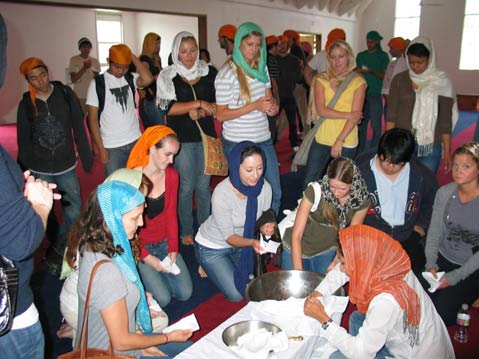Your Friendly Neighborhood Gurdwara
Visiting Ventura's Sikh House of Worship

Tucked away in a Ventura neighborhood stands a chapel-like building, between a small business and a residence on Loma Vista Road. It’s a humble little abode, but drop by the Sikh gurdwara of Ventura County on a Sunday afternoon, slip off your shoes, cover your head as a sign of respect, and you’ll find you’ve entered a very special place.
This weekend, the church-turned-temple came alive when its congregation of Sikh immigrants came together to eat, pray, and worship the text they hold sacred.
The music of traditional Indian instruments and the voices of a few Sikh men clad in white filled the gurdwara. Women draped in bejeweled, richly-colored scarves and dresses sat cross-legged on the carpeted floor. Men lined the right wall of the building, some clad in turbans with unshorn beards, some in more typical American dress.
Children, some in tiny turbans, scurried about the sitting area, smiling at new faces and making new friends. And nearly all wore the Kara, a steel bracelet on the right wrist which is a part of the traditional Sikh uniform.
The congregation faced an altar area, where a beautifully decorated canopy sheltered the Guru Granth Sahib, or the sacred Sikh text. Carefully perched on a throne-like structure, the scriptures’ sovereignty was honored by a man who wove a ceremonial whisk made of white yak hair through this air.
The hymns of a Sikh service come from the Guru Granth Sahib. The songs are poetry of love and thanksgiving, and the lyrics run along a computer screen in three languages: Punjabi (the language of most Sikhs), Gurumukhi (the Sikhs’ sacred script), and an English translation (to enable Sikh children to understand its meaning).
An elderly man sat at the front of the congregation serving karah parshad, which he had previously blessed, to anyone who approached him on their knees with hands cupped and extended. Karah parshad, a sweet, doughy substance made of flour, sugar and butter, is a sacred food, sanctified by prayer. It’s especially sweet.
Following the worship service, the crowd headed downstairs for langar, a meal prepared and served by the entire congregation. Visitors from a UCSB Religious Studies course, with whom this reporter attended the gurdwara, were treated to a hearty meal of rice, lentils, vegetables, yogurt, and unleavened Indian bread.
We were kindly attended to by young men holding buckets of food, who made sure that we’d all had our fill before they sat to eat.
The langar is an integral part of the Sikh tradition for a few reasons, according to Dr. Gurinder Singh Mann, professor of religious and Sikh studies at UCSB and a member of the Ventura congregation. It was Mann who invited the class to come and partake of the gurdwara worship on Sunday, and he made special efforts to explain to us what we didn’t understand.
The langar, he said, represents the Sikh belief in social equality and sharing the fruits of labor. Mann explained that for the Sikhs who remember life in the Punjab, langar represents a radical break with Hindu social traditions.
“Hindu social hierarchy is built around the idea of food,” he said. “A Brahmin can’t eat from the hand of anyone else, but in the gurdwara, the Sikhs eat together, cook together, and clean up afterward together. It means there’s absolutely no place for any social hierarchy of any kind. This was a radical development during the 16th century.”
The langar is also just a part of the celebration of the day’s worship experience, during which the community comes together to share the fruits of their culinary efforts.
The Ventura gurdwara is undoubtedly a special place, filled with warmth and hospitality, and for Mann, its establishment represented an important moment in the local Sikh experience.
After practicing their gurdwara worship for three years in an Oxnard schoolroom, local Sikhs purchased a church, and set about making it their own. When they laid their scriptures inside the building, it became sacred, and it’s been supporting the Sikh community since 2004.
“The site is beautiful and I feel that the Sikhs are lucky to be able to have it,” Mann said. “It was a powerful experience to see the same sacred Christian space transformed into Sikh space, the way the pews were removed and new modes of worship came into place. It was all just very fascinating.”
Mann noted that the gurdwara is an important site for the transmission of culture to younger generations. Most gurdwaras, he said, provide programs for children to learn both Punjabi and the sacred script, and most arrange cultural activities and field trips for younger, second-generation Sikhs.
Every year, Mann escorts his classes to the gurdwara, and every year the congregation extends a warm smile and a hearty lunch to this group of students wearing handkerchiefs, borrowed scarves, and makeshift turbans atop their heads.
“The congregation is happy, and just so grateful that students take time to come,” Mann said. “They are always welcoming and affectionate, and when they ask students to come again, they really mean it. They are just grateful that young Americans are willing to take a couple of hours to come and see what Sikh worship is.”
The Ventura gurdwara is located at 3076 Loma Vista Road in Ventura. It can be reached by phone at (805) 641-0902.



